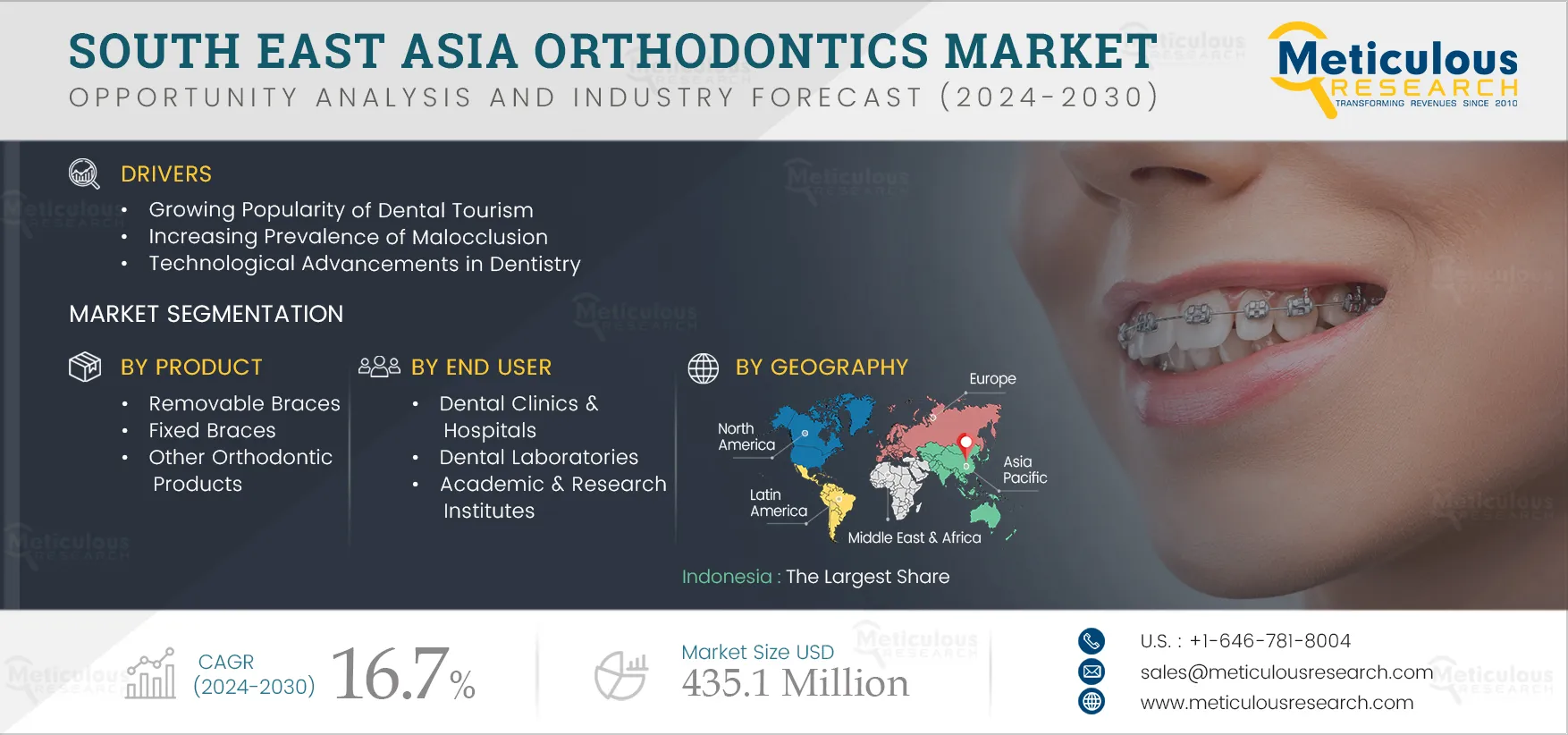Resources
About Us
South East Asia Orthodontics Market by Product [{Removable Braces (Clear Aligners, Retainers) Fixed Braces (Brackets, Archwires, Anchorage, Ligatures) Bands, Adhesives, Springs} Patient {Teen, Adult} End User {Hospital, Dental Clinics}] - Forecast to 2032
Report ID: MRHC - 1041050 Pages: 200 Jul-2024 Formats*: PDF Category: Healthcare Delivery: 24 to 72 Hours Download Free Sample ReportThe South East Asia Orthodontics Market is projected to reach $435.1 million by 2032, at a CAGR of 16.7% from 2025 to 2032. Orthodontics is the branch of dentistry that corrects teeth and jaws that are positioned improperly. Removable braces, brackets, archwires, anchorage appliances, ligatures, and other orthodontic products are used in orthodontic procedures. Orthodontic products are used to correct malocclusions by straightening the teeth or moving them into better positions to improve an individual’s appearance and restore the normal function of teeth of chewing and speaking.
The South East Asia orthodontics market is growing due to the growing popularity of dental tourism, increasing prevalence of malocclusion, technological advancements in dentistry, rising adoption of digital technologies for orthotic procedures, and increasing awareness regarding oral hygiene among the population. However, the limited reimbursement policies and high cost of orthodontics treatment are restraining the growth of this market. Furthermore, the growing demand for customized aligners and the implementation of teledentistry and teleorthodontics are expected to offer better growth opportunities for market expansion. However, budgetary restrictions and lack of awareness regarding orthodontic treatments are the major challenges to the market’s growth.
The awareness regarding orthodontic treatments is low, especially among the public and preadolescents. The South East Asia region has a high incidence of oral cancer and mortality rates associated with chewing of areca nut with or without tobacco. According to the GLOBOCAN, in 2020, nearly 18,381 oral cancer cases were reported in South East Asia, and this number is expected to increase to 30,565 new cases by 2040, while the mortality rate in 2020 was 9,925 and it is expected to reach 17,727 in 2040 in the region. Additionally, several systemic diseases are associated with oral indicators before their actual onset. Therefore, routine oral examinations are crucial for the early detection and treatment of oral diseases.
Furthermore, untreated dental problems, mainly malocclusion, can cause extreme pain and infection, resulting in people’s poor professional productivity and absence from work. The person’s awareness about their malocclusion and the necessity for orthodontic treatment seems to be different at different ages. In addition, a large number of people from the South East Asia region migrate to high-income countries. Migrants who move to high-income countries are considered at risk of poor dental health and malocclusion, mainly due to the significantly higher treatment costs, unavailability of dental health coverage, and poor access to dental care facilities. Thus, the low awareness regarding orthodontic treatments can challenge the market’s growth.

Click here to: Get Free Sample Pages of this Report
The High Prevalence of Malocclusion is Driving the Growth of the Market
The high prevalence of malocclusion is a major driving factor for the South East Asia orthodontics market. Malocclusion can be caused by several factors, such as genetics and thumb-sucking in children, and it can have a negative impact on an individual’s oral health. It is one of the most prevalent clinical dental conditions in South East Asian countries. The prevalence is higher due to insufficient knowledge of oral health care and practices. Malocclusion is the most common oral health problem, following periodontal disease and tooth decay. There are different categories of malocclusion—Class I malocclusion, Class II malocclusion (also known as overbite), and Class III malocclusion (also known as underbite). The high prevalence rate of class III malocclusion was 15.08% in South EastAsia. Additionally, according to the Global Healthy Thinking Report 2021, approximately 23% of the people in Indonesia, 17% of the people in Singapore, and 13% of the people in Thailand desired orthodontic treatments, including clear aligners, as their preferred choice to beautify their smile.
Thus, the high prevalence of malocclusion drives the demand for orthodontic treatments in South East Asia.
In 2025, the Removable Braces Segment is Expected to Account for the Largest Share of the Market
Among all the product types, in 2025, the removable braces segment is expected to account for the largest share of the market due to the high prevalence of malocclusion in children and adults. Removable braces are clear plastic trays that can be snapped in and out from the mouth to correct orthodontic conditions. Further, the treatment of removable braces can be shorter than traditional braces. Malocclusion is a condition where the teeth and jaw bones are misaligned. This condition affects an individual's chewing patterns, speech, and appearance. Thus, the braces are used for correcting misaligned teeth.
In 2025, the Adults Segment is Expected to Account for the Largest Share of the Market
Among all the patient types, in 2025, the adult segment is expected to account for the largest share of the South East Asia orthodontics market. Oral diseases are increasing the demand for orthodontic therapy among adults. The treatment of malocclusions in adults is important for preventing orthodontic complications. Furthermore, over the past few years, the overall diagnosis rate for malocclusions and treatment rates has increased significantly in emerging countries. Thus, the high prevalence of malocclusion in adults has increased the adoption of orthodontic treatments, contributing to the largest share of the segment.
In 2025, the Dental Clinics & Hospitals Segment is Expected to Account for the Largest Share of the Market
Among all the end users, in 2025, the dental clinics & hospitals segment is expected to account for the largest share of the market. The large market share of this segment is attributed to the customized clear aligner orthodontic appliances and services, skilled orthodontic specialists, dental clinics & hospitals that have high availability of advanced digital technologies such as CAD/CAM, 3D intra-oral scanners, 3D printers, digital radiography, etc., Most of the patient pool prefers to get treated for malocclusion disorder in dental clinics and hospitals as they have well-established infrastructure and are well-equipped to get effective treatment. Also, orthodontics procedures have become widely available and accessible as many online dental care companies are collaborating with dental practices to offer their services remotely including direct-to-consumer orthodontics using clear aligners. This allows patients to receive orthodontic treatment from an orthodontist who is registered with the General Dental Council (GDC), which can monitor their progress and make any necessary adjustments to the treatment plan.
Indonesia: Largest Share of the South East Asia Orthodontics Market
In 2025, Indonesia is expected to account for the largest share of the South East Asia orthodontics market. The growth in this market is attributed to the high prevalence rate of malocclusion, highly skilled healthcare professionals, increasing demand for cosmetic dentistry, and growing demand for dental tourism owing to its high-quality services and affordability.
Key Players
The report includes a competitive landscape based on an extensive assessment of the key growth strategies adopted by major market players in the last 3–4 years. The key players profiled in the South East Asia orthodontics market report are Align Technology, Inc. (U.S.), Institut Straumann AG (Switzerland), Henry Schein, Inc. (U.S.), 3M Company (U.S.), DENTSPLY SIRONA Inc. (U.S.), DENTRUM GmbH & Co.KG (Germany), Envista Holdings Corporation (U.S.), Koden, Inc. (U.S.), SmileDirectClub, Inc. (U.S.), Innobrace Orthodontics Pte Ltd (Singapore), ClearSmile Asia Pte. Ltd. (Singapore), Tomy International, Inc. (U.S.), Ultradent Products, Inc. (U.S.), and TP Orthodontics, Inc. (U.S.).
Report Summary:
|
Particular |
Details |
|
Page No |
200 |
|
Format |
|
|
Forecast Period |
2025-2032 |
|
Base Year |
2022 |
|
CAGR |
16.7% |
|
Market Size (Value) |
$435.1 million |
|
Market Size (Volume) |
NA |
|
Segments Covered |
Product, Patient Type, End User |
|
Countries Covered |
Indonesia, Singapore, Thailand, Malaysia, Vietnam, Philippines, and Rest of South East Asia |
|
Key Companies |
Align Technology, Inc. (U.S.), Institut Straumann AG (Switzerland), Henry Schein, Inc. (U.S.), 3M Company (U.S.), DENTSPLY SIRONA Inc. (U.S.), DENTRUM GmbH & Co.KG (Germany), Envista Holdings Corporation (U.S.), Koden, Inc. (U.S.), SmileDirectClub, Inc. (U.S.), Innobrace Orthodontics Pte Ltd (Singapore), ClearSmile Asia Pte. Ltd. (Singapore), Tomy International, Inc. (U.S.), Ultradent Products, Inc. (U.S.), and TP Orthodontics, Inc. (U.S.). |
Scope of the Report:
South East Asia Orthodontics Market, by Product
South East Asia Orthodontics Market, by Patient Type
South East Asia Orthodontics Market, by End User
South East Asia Orthodontics Market, by Country
Key questions answered in the report:
This study offers a detailed assessment of the South East Asia orthodontics market, including the market sizes & forecasts for various market segments such as product, patient type, and end user. The South East Asia orthodontics market study provides an in-depth analysis of several segments & subsegments of orthodontics at the country level.
The South East Asia orthodontics market is projected to reach $435.1 million by 2032, at a CAGR of 16.7% during the forecast period.
In 2025, the removable braces segment is expected to account for the largest share of the South East Asia orthodontics market. The high prevalence of malocclusion and lower costs of fixed braces compared to removable braces contribute to the large market share of this segment.
In 2025, the adult segment is expected to account for the largest share of the market. The increasing demand for cosmetic dentistry and the high prevalence of malocclusion contribute to the large market share of this segment.
The growth of the South East Asia orthodontics market is attributed to the growing popularity of dental tourism, increasing prevalence of malocclusion, technological advancements in dentistry, rising adoption of digital technologies for orthotic procedures, and increasing awareness regarding oral hygiene among the population. Furthermore, the rising demand for customized aligners and implementation of teledentistry and teleorthodontics offers significant opportunities for the market’s growth.
The key players profiled in the South East Asia orthodontics market study are Align Technology, Inc. (U.S.), Institut Straumann AG (Switzerland), Henry Schein, Inc. (U.S.), 3M Company (U.S.), DENTSPLY SIRONA Inc. (U.S.), DENTRUM GmbH & Co.KG (Germany), Envista Holdings Corporation (U.S.), Koden, Inc. (U.S.), SmileDirectClub, Inc. (U.S.), Innobrace Orthodontics Pte Ltd (Singapore), ClearSmile Asia Pte. Ltd. (Singapore), Tomy International, Inc. (U.S.), Ultradent Products, Inc. (U.S.), and TP Orthodontics, Inc. (U.S.).
South East Asia countries such as Indonesia, Singapore, and Thailand offer significant growth opportunities for the players operating in this market due to the high prevalence of malocclusion, growing dental tourism, rising awareness of advanced orthodontic treatments, and rising healthcare spending.

























Published Date: Jul-2024
Published Date: Jul-2024
Published Date: Mar-2024
Please enter your corporate email id here to view sample report.
Subscribe to get the latest industry updates